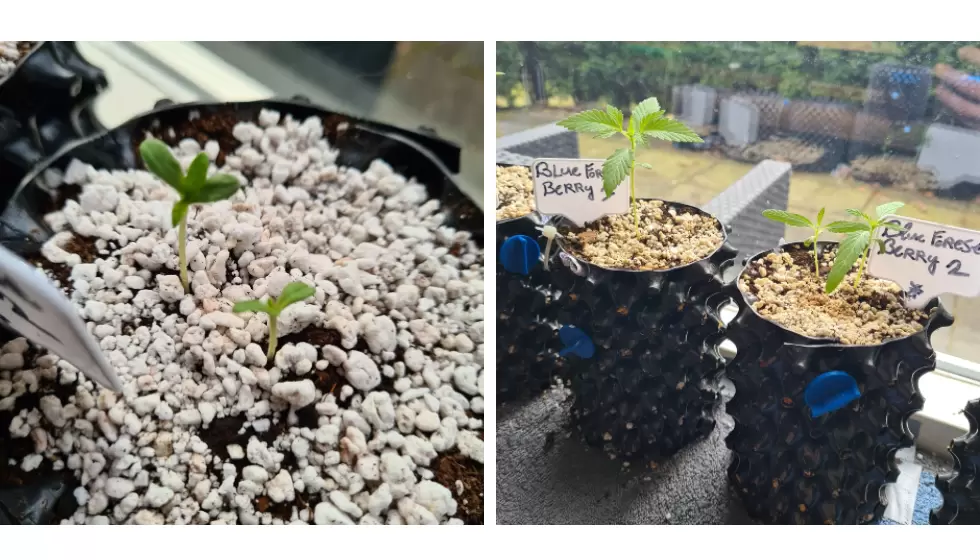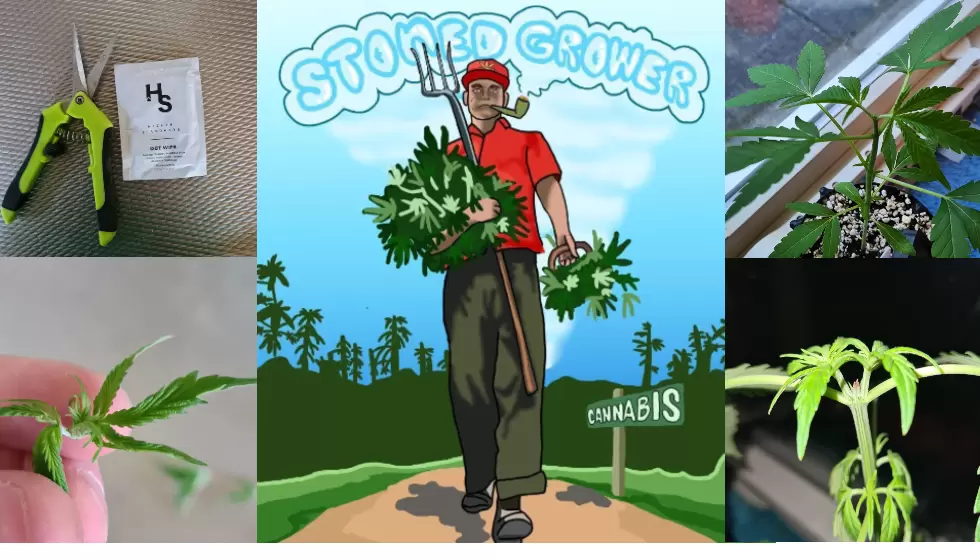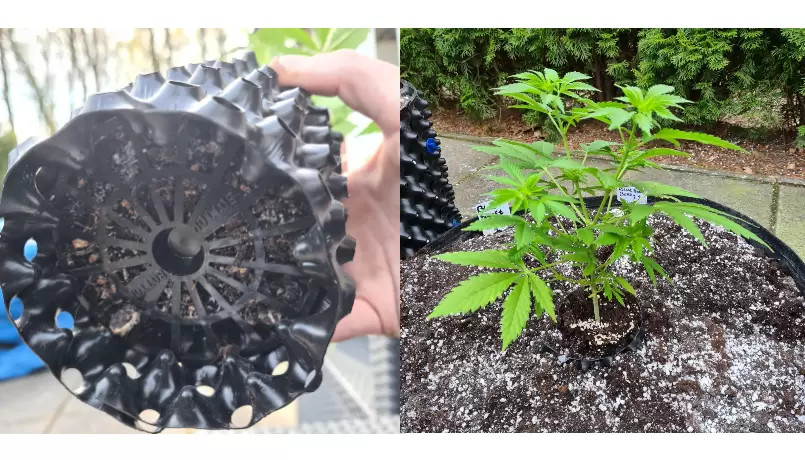OUTDOOR CANNABIS GROWTH REPORT: FROM GERMINATION PHASE TO YOUNG GROWTH PHASE

Welcome to my Outdoor Cannabis Grow Report for this year. Most of your green hands will be itching to put something in the ground. In general, it is best to wait a while for the outdoor cultivation until the chance of frost has completely passed. Can't really wait any longer? In this Outdoor Cannabis Grow Report, we'll explain exactly how best to start your outdoor cannabis grow to ensure successful cannabis cultivation!
How do you choose the right cannabis seeds?
Unfortunately, in our little country we have to deal with not really optimal weather conditions for growing cannabis outdoors. Still, you can get some pretty good breeding results if you follow a few basic rules and follow proven tips and tricks. It is important that you look closely at the correct genetics and whether the cannabis strain in question is also properly "stabilized". It is therefore wise to choose a good cannabis seed supplier and also look at the classic Dutch cannabis strains. In any case, choose cannabis strains that can withstand the (Dutch) cold, high humidity and varying temperatures. It is therefore also wise to choose cannabis strains that are resistant to diseases and fungi. We also call this mold resistance and genetics play a major role in this.
If you have opted for photoperiod cannabis seeds, choose photoperiod strains that generally have a not too long flowering time (6 up to 9 weeks of flowering). Photoperiod cannabis seeds with a longer flowering time are of course also possible, but there is a greater chance of bud rot and other fungi later in the year during the longer flowering period. If you have opted for a cannabis strain with a longer flowering time, it is advisable to choose the autoflower seeds of the selected cannabis strain. In short, an autoflower is an auto-flowering cannabis plant. By choosing the autoflower variant, you skip a large part of the growth period of the cannabis plant and thus you can still grow your desired cannabis type with a good result. Autoflower cannabis plants generally yield a lot less, although this can often be compensated for by applying good training techniques to your autoflower cannabis plants. Moreover, it is certainly possible to realize two growing rounds of autoflower cannabis plants in one season. For those with good planning (and some luck) it is even possible to complete three full rounds of grow in one season!
If you have opted to grow autoflower cannabis strains outdoors, grow the cannabis plants in pots of about 10 to 30 liters and no bigger. Growing autoflower cannabis strains in larger pots is of little use and is also a waste of your raw materials (food, soil, etc.). If you have chosen to grow a photoperiod cannabis strain outdoors, then this rule does not apply and there is generally no limit to the size of the pots. The bigger the better, they say. If you have the option to grow in the ground, then you can create a monstrous cannabis plant, especially if you first prepare the soil well and ensure that all the necessary nutrients are present in the soil.
Which cannabis strains have I chosen for my outdoor cannabis grow this year?
I have amassed a huge collection of cannabis seeds and will be growing a number of cannabis strains this year that are coffee shop menu would not have been out of place! A wide range of all kinds of different cannabis strains from different and well-known seed suppliers. The following cannabis strains are planned for this year's outdoor cannabis cultivation:
- Hollands Hope (Dutch Passion)
- BigBud
- Monster Zkittlez (Zamnesia Seeds)
- Blue Forest Berry (Growerschoice)
- Mohammed (CNNBS x Seedstockers
- Critical + (Inseedious)
- Purple Kush Auto (Inseedious)
Optional for a second and possibly third autoflower grow round:
- Autoflower Blancaneu, also known as Snow White Auto (CNNBS x Seedstockers)
- Autoflower Camelberry (CNNBS x Seedstockers)
As you can see, I hope to make it another great cannabis outdoor growing year this year and of course I sincerely hope this for you too. I hope to help you with this too. 
The start of cannabis outdoor cultivation: the germination of the cannabis seeds
I started germinating early this year , namely in the beginning of March! Starting up the (outdoor) cultivation is also called breeding gene oemd. Now you are probably wondering how to grow cannabis without the help of grow lights? Actually, the answer to this vrag simple. It is also very well possible to grow cannabis behind the window with the help of a living room lamp, although this does require some explanation if you want to have healthy cannabis plants and increase the chances of success.
Anyway, first you start. naturally with the germination of your cannabis seeds. This is of course possible with the germination method of your choice. I opted for the coffee filter method, a method that has rarely or never failed many cannabis growers. This method is hugely successful and quite simple. You moisten an unbleached coffee filter and put (up to 5) cannabis seeds in it, with the pointed / pointed side down. The root will grow from the pointed side. The root then grows down immediately so that it can develop optimally. If you plan to put more than one cannabis seed in the coffee filter, make sure there is enough space between the cannabis seeds. Then you put the coffee filter, with the cannabis seeds in it, in a plastic (grip) bag. You can possibly spray some more water here before sticking the bag with duct tape or adhesive tape to the inside of, for example, a kitchen cupboard or somewhere else where it is dark and there is absolutely no light.
By 1 to 5 days, a root of an inch or more will have emerged from the cannabis seed. If not, be a little more patient. If nothing really happened after more than 7 - 10 days, add a drop of root stimulator in the moist coffee filter with the cannabis seed (s). When the cannabis seeds have germinated properly, the time has finally come that you can put the cannabis seeds in the ground or in cultivation pots. In my case, after germination, I immediately put the cannabis seeds in small cultivation pots of 0.7 to 1L. Because we only want to pre-grow (propagate) the cannabis plants in this, we choose a not too large size. You can of course also choose larger pots for pre-growing cannabis. You fill the cultivation pot (s) half with soil (or coconut) and you make a small hole in the middle. You then put the germinated cannabis seed in this hole, with the root down. It goes without saying, but let's say it anyway: put a maximum of 1 cannabis seed per cultivation pot! You really DON'T want young cannabis seedlings to compete with each other for light, moisture, nutrients and space, while also risking getting entangled with their roots.
Place the cannabis seeds in the hole and cover afterwards with a small layer of soil (or coconut). Make sure there is about an inch to a few inches of soil (or coco) over the cannabis seed. Now also add some water. However, do not overwater! In general, 50 - 100ml is more than enough for young cannabis seedlings. Do not only ensure a higher humidity during the germination of the cannabis seeds, but also during the young seedling phase. Young cannabis plants love humidity and it also ensures that the seed pods come off more easily. A propagator, a little perlite and a spray bottle can certainly help to achieve the desired (air) humidity. After a few days you can see the stem and the first 2 small leaves emerge, these are the so-called lobe leaves. If the seed shell is still (partly) on the cannabis seed, it is best to just let it go naturally and not pick it yourself, as this can damage the lobe leaves. As mentioned above, a high (er) humidity also aids in the natural release of the seed shell.
I started germinating the selected cannabis seeds on March 3rd and have almost all be able to put germinated seeds in small pre-growth pots (cultivation pots) on 6 March. The rest of the germinated cannabis seeds followed a day later. On March 9, both Blue Forest Berries emerged, followed by the first Mohammed and the first Purple Kush Auto. The majority followed a day later: the second Mohammed, the second Purple Kush Auto, a Monster Zkittlez, the Critical +, the Hollands Hope and the Big Bud. Last but not least, the third Purple Kush Auto emerged from the ground on March 13.
Pregrow indoors
From the moment your cannabis plant emerges above the ground, we speak from a young seedling that will slowly transition to a (young) vegetative cannabis plant. From the moment the cannabis plant rises above the ground, it is important for photoperiod cannabis plants to provide extra lighting to prevent premature flowering. With our breeding, this was from the appearance of the first seedling on March 9. In March and also in early April it is not yet (far) 14 hours of light a day outside. To avoid this, make sure there is always light at your cannabis grow spot for at least 14 hours a day. Until it is light outside for 14 hours, during the pre-growth phase you can place the nursery pots with the cannabis seedlings in them on the windowsill behind the window and leave the lamp in the room on for a few extra hours a day. if it is light outside for at least 14 hours a day, then you can stop this and nature will take care of the rest. This year this was around April 17. Still maintain a humidity of at least 50% or more. For young cannabis plants, a humidity between 55% and 75% is best.
Giving water (and root stimulator) is of course also very important. Always make sure to water your cannabis plants (and root stimulator) 2-3 times a week and in some cases 4 times. A good wet-dry cycle is important for healthy cannabis plants. Never make your soil soaking wet, but moist. Let this then be absorbed by the cannabis plants and dry by evaporation and then, often a day or two or three later, water again and keep repeating this. Do not forget to add some root stimulator when watering. As your cannabis plants grow, you naturally also adjust the amount of water and root stimulator you give. In general, the volume of water you give (for small pots) is about 1/5 to 1/8 of the total pot volume. Allow the moisture to absorb into the soil (or coconut) and dry almost completely until you water again. After a week or a few weeks, you can also completely fill the growing pot with soil / coconut. You only need to fill the growing pot with soil / coconut in case your cannabis plant has started to stretch behind the window. It is then very convenient that you can simply bury a large part of the stem of the cannabis plant when replenishing, because this part of the stem will turn into root (s) once it is underground. As a result, your cannabis plant is firmly in the ground again and it also stretches less. After a week or a few weeks, it is also a good idea to start slowly with growth nutrients. When you start with this and exactly how much you are going to give is completely dependent on the chosen potting soil and the growth fertilizer that is being grown with. Often the recommended dose is on the website of the nutritional supplier. 
Why and how do I top my cannabis plant?
In just a few weeks time, all the seeds are up to young. vegetative cannabis plants. This is good news and also means that I can now start applying cultivation and / or pruning techniques. In this case, photoperiod cannabis plants are all about topping them. Topping is a high stress pruning technique that you use to get your cannabis plant to produce two or many more (main) buds instead of one main bud and to make the cannabis plant grow wider. In general, this ensures that instead of a tree structure, more of a shrub structure is adopted by the cannabis plant. The topping can be done an unlimited number of times, taking into account the recovery time. Only top (or FIM) your plants during the growth period and absolutely NOT during the flowering period! If you do this during the flowering period of the cannabis plant, then this will not result in more but (much) less harvest. Pruning and training, including topping your cannabis plant during the growing period, if done correctly, will result in (much) more cannabis yield when it is finally harvest time.
Topping (en also FIMs) are pruning techniques that every cannabis grower, beginner or advanced, should know and try. These techniques are among the standard cannabis pruning techniques among many growers and many master these techniques to perfection. Don't be too afraid of making mistakes as a beginner. Do you want to top and miss? Then you literally have a FIM, which stands for Fuck i Missed ! So it does not matter when trying out the topping and / or FIMing of your cannabis plant and making a small mistake. the cannabis plant (also called the crown or crown), cut, cut or break off. Every cannabis grower has his own preference for this. However, as a novice cannabis grower, we recommend that you do this with sterile and clean pruning or trimming scissors. Would you rather FIM? Then you cut a (large) part of the top, but not all! An FIM can actually be seen as a failed attempt to top the cannabis plant, leaving a (small) part of the top of the cannabis plant behind.
The photoperiod cannabis plantsof my outdoor cultivation all were successfully topped for the first time on April 11 and are (at the time of writing) still recovering. The recovery time for a well-executed top is about 5 days to a maximum of 2 weeks. Now, a few days later, we are already seeing some results, as the cannabis plants are starting to form more like a bush. So this mission seems to have been successful so far! Now the cannabis plants just have to create two or more main buds. & Nbsp;
The autoflower cannabis plants are being repotted and are already going outside
At the time of writing I'm in the sixth week of growing, which means that the autoflower cannabis plants will be ready to flower at any time! It is because of this that I am forced to pot the autoflowers of my cannabis, namely the three Purple Kush Cars, and put them outside. You absolutely do NOT want to repot the cannabis plants when they are already in bloom. This is at the expense of the end result and therefore your yield. You also prefer not to let autoflower cannabis plants flower in 0.7 to 1L growing pots. There are certainly cannabis growers who still achieve good results with small pot sizes, but then we often talk about an optimized interior view with a professional grow light and all the trimmings. For this outdoor cannabis grow report, I grow without a grow light, so the cannabis plants will have to be repotted before they go into bloom, to allow them to reach their optimal size and thus guarantee a maximum harvest.
Due to the size of the cultivation pots (20L Air-Pot) that we have chosen for the next phase of life of the three autoflower cannabis plants, it is not possible to place these three pots on the windowsill behind the window. So the weed plants have to go outside because of a lack of space behind the window. In addition, it is a nice side effect that the cannabis plants will also receive UV radiation from the sun, because behind the window that radiation is not there at all or, in the best case, still very scarce. Every window and mainly with double glazing breaks down the UV light (largely). On April 12th, the three autoflower cannabis strains (Purple Cush) were transferred to their new 20L Air-Pots and are therefore permanently outside. Let's hope everything goes well!

Some tips for transplanting your cannabis plant:
- Repot your cannabis plant when the roots are visible at the bottom and / or the entire pot is filled to the bottom with roots. Please note: there must be at least a number of branches before you repot them.
- Another rule of thumb is: repot the cannabis plant when the plant is about the same size or a maximum of one and a half times as high as the pot itself. However, this only applies to cultivation pots with a small size and normal shape and not for large pots (15+ L) or deviating shapes such as containers / tubs.
- Make sure that the soil in the pot where your cannabis plant is it is not too dry, but also not too wet, so slightly moist. This will make it easier to repot the cannabis plant, as the soil will be less likely to disintegrate.
- Make a hole or hole in the soil of the new and larger nursery pot into which the cannabis plant will be repotted. The most convenient is to make an impression in the soil of the new pot with the pot that your cannabis plant is still in, so that you can better estimate the size and depth of the hole to be made.
- Keep pot with cannabis plant and all upside down with the stem between 2 fingers. With the other hand you can then carefully '' knead '' the jar, & nbsp; this releases the plant and the soil well. When the whole thing comes loose, you can actually start repotting the cannabis plant.
- If your cannabis plant has started to stretch behind the window, dig it a little deeper. The part of the stem that is now under the ground will automatically change into root (s), because it will no longer receive (sun) light under the ground.
- Once the cannabis plant has been placed in the previously created hole, press the soil very gently and fill it all up with some more soil.
- Now that your cannabis plant has been firmly and safely repotted in the new pot, you can add some water and give a root stimulator and if necessary also some growth fertilizer. All of this ensures a good start of the roots, a reduction of the shock and reduced stress that the cannabis plant all undergoes by repotting.
- After repotting, a cannabis plant always needs some recovery time before it actually becomes visible. starts to grow. This recovery time actually applies after applying any (other) cultivation and / or pruning technique. The recovery time differs per situation and per cannabis strain,but the recovery time after repotting a cannabis plant takes about a week.
Finally, I would like to make it clear that you prefer to put autoflower cannabis plants outside in (early-mid) May, officially after Ice Saints only. And photoperiod cannabis plants could be put outside at the earliest (end of) April. I am just a stubborn cannabis grower, I love to experiment and have already planned a second and maybe even a third round of autoflower cannabis cultivation for outdoor cannabis this year! Do you have questions about the different types of cannabis seeds? Then get in touch with the expert team 24High.
The next blog about my Outdoor Cannabis Grow Report this year will be about the growth phase of the photoperiod cannabis plants where we will also repot them and about the flowering phase of the already repotted autoflower cannabis plants. And if it has all been going a bit by then, I might even talk about harvesting the first round of autoflower cannabis plants and germinating the new and second round of Autoflowers in the next blog!
This blog was written by @Thestonedgrower on Instagram.

















